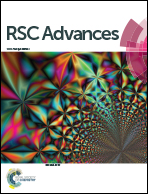Factors that influence the degradation of 1-ethyl-3-methylimidazolium hexafluorophosphate by Fenton oxidation†
Abstract
Stable and anti-biological ionic liquids are difficult to degrade in wastewater. Classical Fenton oxidation has been proved to be an efficient treatment for the degradation of various toxic organic pollutants in aqueous solution. However, its oxidizing ability to degrade short-chain and hydrophilic ionic liquid has not been carefully evaluated. In this work, batch experiments were carried out to investigate systemically the role of pH, temperature, substrate concentration, hydrogen peroxide and ferrous levels, as well as coexisting halogen anions and small molecular organic acids in the degradation of 1-ethyl-3-methylimidazolium hexafluorophosphate ([C2mim][PF6]). Optimum condition occurred at starting conditions of pH 3.0, 5 mmol L−1 Fe(II) dosage and 20 mmol L−1 H2O2 concentration at 313 K. Under such conditions, the degradation efficiency of 2 mmol L−1 [C2mim][PF6] concentration is up to 89.4%. Coexisting halogen anions (F−, Cl− and Br−) and organic acids (acetic, oxalic and citric acids) significantly inhibited the degradation efficiency of Fenton oxidation. The influence of counter anions was also investigated. Finally, the mineralization of [C2mim][PF6] after 120 min in Fenton system was detected and some possible intermediates were deduced.


 Please wait while we load your content...
Please wait while we load your content...